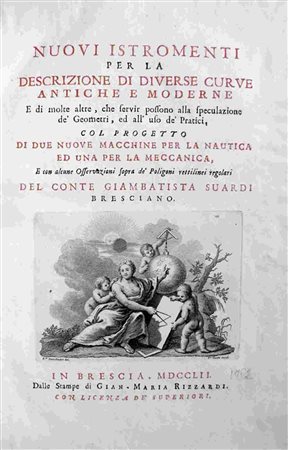 Bertolami Fine Art - Sendlinger Straße 24, 80331 Monaco
Bertolami Fine Art - Sendlinger Straße 24, 80331 Monaco
WEB AUCTION 118 - LIBRI E AUTOGRAFI WEB AUCTION 118 - LIBRI E AUTOGRAFI
giovedì 16 giugno 2022 ore 14:00 (UTC +01:00)
GIAMBATTISTA SUARDI (1711-1767): Nuovi istromenti per la descrizione di diverse curve antiche e moderne e di molte altre, che servir possono alla speculazione de’ geometri, ed all’uso de’ pratici, col
Giambattista Suardi (1711-1767)
Nuovi istromenti per la descrizione di diverse curve antiche e moderne e di molte altre, che servir possono alla speculazione de’ geometri, ed all’uso de’ pratici, col progetto di due nuove macchine per la nautica ed una per la meccanica…o In Brescia, dalle stampe di Gian Maria Rizzardi, 1752
§ 4to (290 x210 cm.); [8], VIII, 283, [1] pp., signature: §1-4, *1-4, A-Z1-4, Aa-Nn1-4; engraved portrait of the Doge Francesco Loredan, XXXIV engraved folding plates, large- size engraved vignette on title page, engraved head-pieces and initials. Portrait by Fortunato Pasquetti (1690-1773), vignette by Francesco Fontebasso (1707-1769), both engraved by Francesco Zucchi (1692-1764). Contemporary vellum, spine gilt. Inner hinge loose otherwise very fine copy.
First edition of this work by the Italian mathematician and inventor Giambattista Suardi. The best known of the “machines” here described is the Geometric Pen or ellipsograph, an instrument by which is possible to draw more than 1200 geometric figures, many of them taking the shape of flowers. “The Geometric Pen utilizes a vertical axle with a revolving arm, which pivots at the center of a tripod support. The revolving arm carries a second pivoting arm fitted with a writing tip. With a series of gears, the rotation of the two arms generates complex cycloidal curves. The importance of Suardi's work is made clear by the fact that it seems all subsequent devices for generating geometric curves are based on his research and inventions.” (Ornamental Turning). The book contains also two letters from Boscovich to Suardi about the latter’s mechanical description of Cartesian ovals“Bella e pregiata edizione” (Riccardi). Ref: Poggendorff II, 950; Riccardi I (2), 479.












